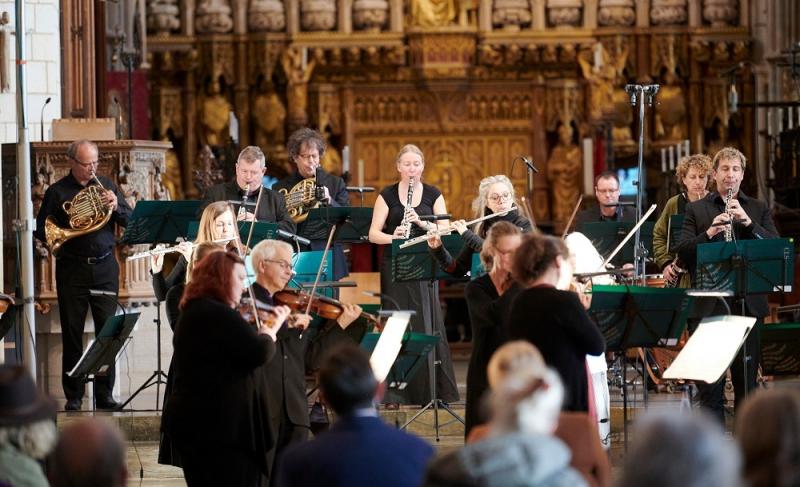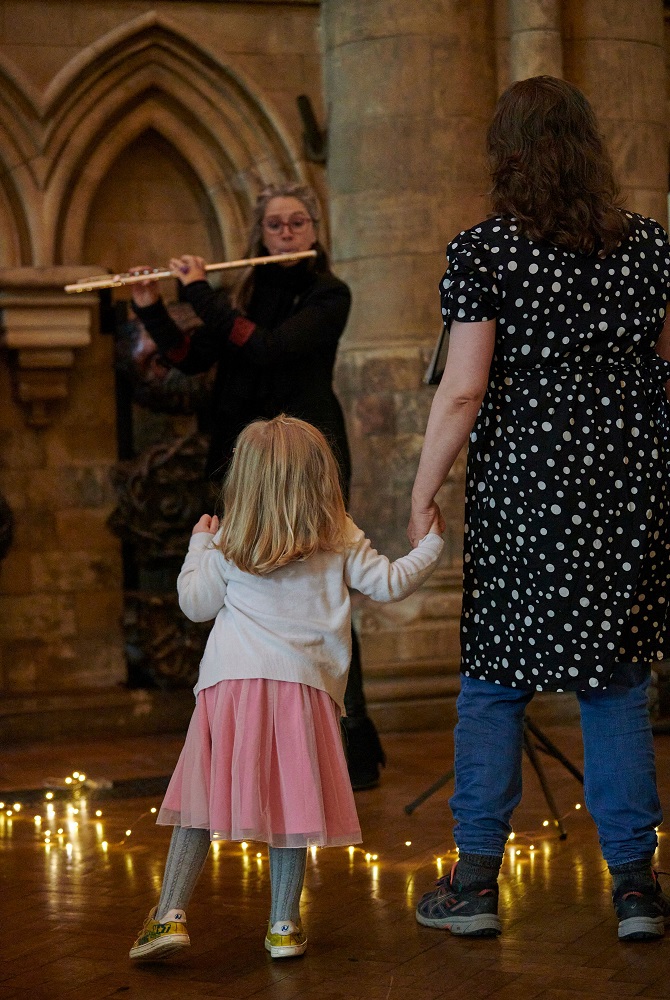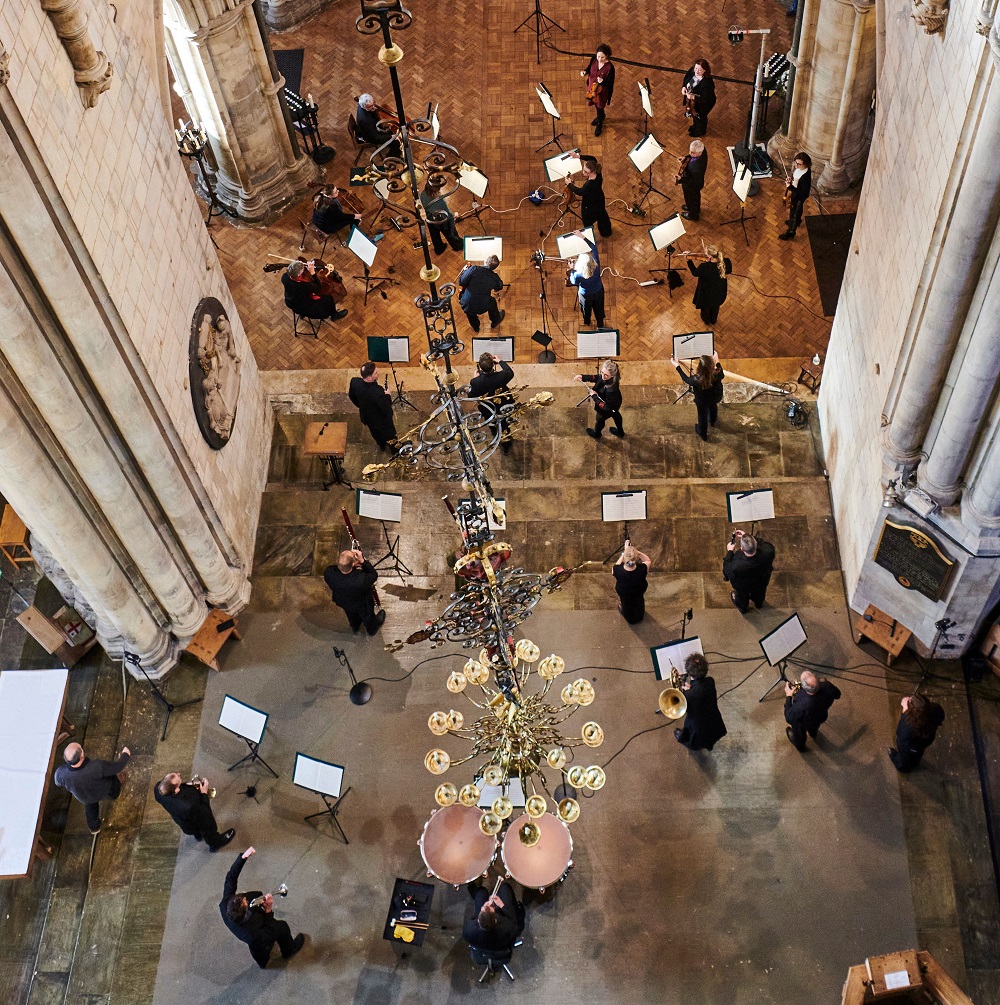City of London Sinfonia, Southwark Cathedral review – towards Haydn’s last symphony | reviews, news & interviews
City of London Sinfonia, Southwark Cathedral review – towards Haydn’s last symphony
City of London Sinfonia, Southwark Cathedral review – towards Haydn’s last symphony
These players have a unique way of welcoming audiences into the concert experience

Nearly two weeks into the latest lockdown, and already I feel nostalgic about the last day of freedom. You should too, just watching the film released last night of the CLS’s most recent happening in Southwark Cathedral.
Haydn had more forces at his disposal in London, thanks to impresario Salomon, than at the Esterházy court in Eisenstadt for which he wrote the majority of his always experimental symphonies. This move towards a remarkably full orchestra had been prepared not just by what came immediately before it that Wednesday, but across the triptych of CLS concerts in the cathedral. They began with Sitkovetsky’s trio arrangement of Bach’s Goldberg Variations, continued with a bracing string-orchestra concert of Elgar and Tchaikovsky, and continued in the Haydn concert with chamber-musical movements.
 Before those we had the benefit of what I see on the film is called “talking programme notes”. My friend and I found ourselves at the west end in the company of flautist Karen Jones plus a delightfully balletic little girl and her mother (pictured right). A gift to all the players she visited, the enthusiastic child had it right – so much of Haydn is about dancing, especially in the perky tune above the drone bass in the finale, with which the players were to have so much fun. I thought she might like to hear fluttertonguing on the flute, even though that plays no part in 18th century music, and Karen was happy to oblige. It’s good to see on the film how well violinist Charlotte Reid sets up her part in the proceedings.
Before those we had the benefit of what I see on the film is called “talking programme notes”. My friend and I found ourselves at the west end in the company of flautist Karen Jones plus a delightfully balletic little girl and her mother (pictured right). A gift to all the players she visited, the enthusiastic child had it right – so much of Haydn is about dancing, especially in the perky tune above the drone bass in the finale, with which the players were to have so much fun. I thought she might like to hear fluttertonguing on the flute, even though that plays no part in 18th century music, and Karen was happy to oblige. It’s good to see on the film how well violinist Charlotte Reid sets up her part in the proceedings.
Options for attendance were seats in the central nave or places at the sides for ambulation. You had to keep walking, though, after the trumpet summons from the beginning of the symphony which marked the official start of the concert, to hear four of the players (Martin Burgess, Clare Hayes, Matt Maguire and Will Schofield) near the high altar in the first movement of Haydn’s D minor String Quartet, Op. 76 No. 2 – severity lightened by moments of grace, like the Ligeti Bagatelle No. 2 for wind quintet, further west, which had us returning to our seats. The intensity has much to do with the players standing – as do the rest of the orchestra other than cellos and double bass, especially personable in kicking off the rustic dance-finale of the symphony.. As in the Tchaikovsky and Elgar serenades, leader Alexander Wood’s vivacious, focused energy gives the cue to a very individual “London” Symphony – the contrasts of its first two movements dramatic, the Minuet playfully free, the finale staying high and bright even in these acoustics, which don’t blur, but seem best for strings and wind in isolation. Still, there couldn’t be a better venue for covering all bases in what the CLS so boldly does, without patronising or gimmickry, to welcome the live audience into the full experience. We’ll need much more of this in the year to come, and hopefully more people will be hungry to experience the life-changing dialogues between players and listeners possible in the flesh.
As in the Tchaikovsky and Elgar serenades, leader Alexander Wood’s vivacious, focused energy gives the cue to a very individual “London” Symphony – the contrasts of its first two movements dramatic, the Minuet playfully free, the finale staying high and bright even in these acoustics, which don’t blur, but seem best for strings and wind in isolation. Still, there couldn’t be a better venue for covering all bases in what the CLS so boldly does, without patronising or gimmickry, to welcome the live audience into the full experience. We’ll need much more of this in the year to come, and hopefully more people will be hungry to experience the life-changing dialogues between players and listeners possible in the flesh.
rating
Explore topics
Share this article
The future of Arts Journalism
You can stop theartsdesk.com closing!
We urgently need financing to survive. Our fundraising drive has thus far raised £49,000 but we need to reach £100,000 or we will be forced to close. Please contribute here: https://gofund.me/c3f6033d
And if you can forward this information to anyone who might assist, we’d be grateful.

Subscribe to theartsdesk.com
Thank you for continuing to read our work on theartsdesk.com. For unlimited access to every article in its entirety, including our archive of more than 15,000 pieces, we're asking for £5 per month or £40 per year. We feel it's a very good deal, and hope you do too.
To take a subscription now simply click here.
And if you're looking for that extra gift for a friend or family member, why not treat them to a theartsdesk.com gift subscription?
more Classical music
 Willis-Sørensen, Ukrainian Freedom Orchestra, Wilson, Cadogan Hall review - romantic resilience
Passion, and polish, from Kyiv's musical warriors
Willis-Sørensen, Ukrainian Freedom Orchestra, Wilson, Cadogan Hall review - romantic resilience
Passion, and polish, from Kyiv's musical warriors
 BBC Proms: The Marriage of Figaro, Glyndebourne Festival review - merriment and menace
Strong Proms transfer for a robust and affecting show
BBC Proms: The Marriage of Figaro, Glyndebourne Festival review - merriment and menace
Strong Proms transfer for a robust and affecting show
 BBC Proms: Faust, Gewandhausorchester Leipzig, Nelsons review - grace, then grandeur
A great fiddler lightens a dense orchestral palette
BBC Proms: Faust, Gewandhausorchester Leipzig, Nelsons review - grace, then grandeur
A great fiddler lightens a dense orchestral palette
 BBC Proms: Jansen, Royal Concertgebouw Orchestra, Mäkelä review - confirming a phenomenon
Second Prom of a great orchestra and chief conductor in waiting never puts a foot wrong
BBC Proms: Jansen, Royal Concertgebouw Orchestra, Mäkelä review - confirming a phenomenon
Second Prom of a great orchestra and chief conductor in waiting never puts a foot wrong
 BBC Proms: Royal Concertgebouw Orchestra, Mäkelä review - defiantly introverted Mahler 5 gives food for thought
Chief Conductor in Waiting has supple, nuanced chemistry with a great orchestra
BBC Proms: Royal Concertgebouw Orchestra, Mäkelä review - defiantly introverted Mahler 5 gives food for thought
Chief Conductor in Waiting has supple, nuanced chemistry with a great orchestra
 Dunedin Consort, Butt / D’Angelo, Muñoz, Edinburgh International Festival 2025 review - tedious Handel, directionless song recital
Ho-hum 'comic' cantata, and a song recital needing more than a beautiful voice
Dunedin Consort, Butt / D’Angelo, Muñoz, Edinburgh International Festival 2025 review - tedious Handel, directionless song recital
Ho-hum 'comic' cantata, and a song recital needing more than a beautiful voice
 Classical CDs: Dungeons, microtones and psychic distress
This year's big anniversary celebrated with a pair of boxes, plus clarinets, pianos and sacred music
Classical CDs: Dungeons, microtones and psychic distress
This year's big anniversary celebrated with a pair of boxes, plus clarinets, pianos and sacred music
 BBC Proms: Liu, Philharmonia, Rouvali review - fine-tuned Tchaikovsky epic
Sounds perfectly finessed in a colourful cornucopia
BBC Proms: Liu, Philharmonia, Rouvali review - fine-tuned Tchaikovsky epic
Sounds perfectly finessed in a colourful cornucopia
 BBC Proms: Suor Angelica, LSO, Pappano review - earthly passion, heavenly grief
A Sister to remember blesses Puccini's convent tragedy
BBC Proms: Suor Angelica, LSO, Pappano review - earthly passion, heavenly grief
A Sister to remember blesses Puccini's convent tragedy
 BBC Proms: A Mass of Life, BBCSO, Elder review - a subtle guide to Delius's Nietzschean masterpiece
Mark Elder held back from blasting the audience with a wall of sound
BBC Proms: A Mass of Life, BBCSO, Elder review - a subtle guide to Delius's Nietzschean masterpiece
Mark Elder held back from blasting the audience with a wall of sound
 BBC Proms: Le Concert Spirituel, Niquet review - super-sized polyphonic rarities
Monumental works don't quite make for monumental sounds in the Royal Albert Hall
BBC Proms: Le Concert Spirituel, Niquet review - super-sized polyphonic rarities
Monumental works don't quite make for monumental sounds in the Royal Albert Hall
 Frang, Romaniw, Liverman, LSO, Pappano, Edinburgh International Festival 2025 review - sunlight, salt spray, Sea Symphony
Full force of the midday sea in the Usher Hall, thanks to the best captain at the helm
Frang, Romaniw, Liverman, LSO, Pappano, Edinburgh International Festival 2025 review - sunlight, salt spray, Sea Symphony
Full force of the midday sea in the Usher Hall, thanks to the best captain at the helm

Add comment